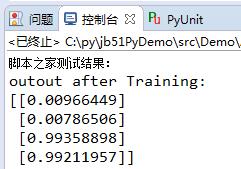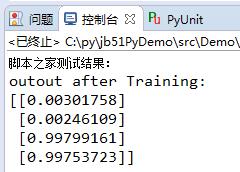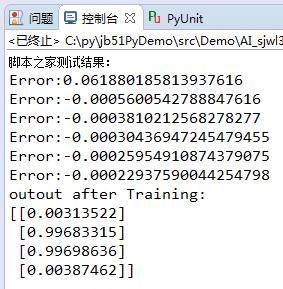怎么在Python中实现一个神经网络算法?很多新手对此不是很清楚,为了帮助大家解决这个难题,下面小编将为大家详细讲解,有这方面需求的人可以来学习下,希望你能有所收获。
python的五大特点:1.简单易学,开发程序时,专注的是解决问题,而不是搞明白语言本身。2.面向对象,与其他主要的语言如C++和Java相比, Python以一种非常强大又简单的方式实现面向对象编程。3.可移植性,Python程序无需修改就可以在各种平台上运行。4.解释性,Python语言写的程序不需要编译成二进制代码,可以直接从源代码运行程序。5.开源,Python是 FLOSS(自由/开放源码软件)之一。
python实现二层神经网络
包括输入层和输出层
# -*- coding:utf-8 -*- #! python2 import numpy as np #sigmoid function def nonlin(x, deriv = False): if(deriv == True): return x*(1-x) return 1/(1+np.exp(-x)) #input dataset x = np.array([[0,0,1], [0,1,1], [1,0,1], [1,1,1]]) #output dataset y = np.array([[0,0,1,1]]).T np.random.seed(1) #init weight value syn0 = 2*np.random.random((3,1))-1 print "亿速云测试结果:" for iter in xrange(100000): l0 = x #the first layer,and the input layer l1 = nonlin(np.dot(l0,syn0)) #the second layer,and the output layer l1_error = y-l1 l1_delta = l1_error*nonlin(l1,True) syn0 += np.dot(l0.T, l1_delta) print "outout after Training:" print l1
这里,
l0:输入层
l1:输出层
syn0:初始权值
l1_error:误差
l1_delta:误差校正系数
func nonlin:sigmoid函数
这里迭代次数为100时,预测结果为

迭代次数为1000时,预测结果为:

迭代次数为10000,预测结果为:

迭代次数为100000,预测结果为:

可见迭代次数越多,预测结果越接近理想值,当时耗时也越长。
python实现三层神经网络
包括输入层、隐含层和输出层
# -*- coding:utf-8 -*- #! python2 import numpy as np def nonlin(x, deriv = False): if(deriv == True): return x*(1-x) else: return 1/(1+np.exp(-x)) #input dataset X = np.array([[0,0,1], [0,1,1], [1,0,1], [1,1,1]]) #output dataset y = np.array([[0,1,1,0]]).T syn0 = 2*np.random.random((3,4)) - 1 #the first-hidden layer weight value syn1 = 2*np.random.random((4,1)) - 1 #the hidden-output layer weight value print "亿速云测试结果:" for j in range(60000): l0 = X #the first layer,and the input layer l1 = nonlin(np.dot(l0,syn0)) #the second layer,and the hidden layer l2 = nonlin(np.dot(l1,syn1)) #the third layer,and the output layer l2_error = y-l2 #the hidden-output layer error if(j%10000) == 0: print "Error:"+str(np.mean(l2_error)) l2_delta = l2_error*nonlin(l2,deriv = True) l1_error = l2_delta.dot(syn1.T) #the first-hidden layer error l1_delta = l1_error*nonlin(l1,deriv = True) syn1 += l1.T.dot(l2_delta) syn0 += l0.T.dot(l1_delta) print "outout after Training:" print l2
运行结果:

看完上述内容是否对您有帮助呢?如果还想对相关知识有进一步的了解或阅读更多相关文章,请关注亿速云行业资讯频道,感谢您对亿速云的支持。
免责声明:本站发布的内容(图片、视频和文字)以原创、转载和分享为主,文章观点不代表本网站立场,如果涉及侵权请联系站长邮箱:is@yisu.com进行举报,并提供相关证据,一经查实,将立刻删除涉嫌侵权内容。